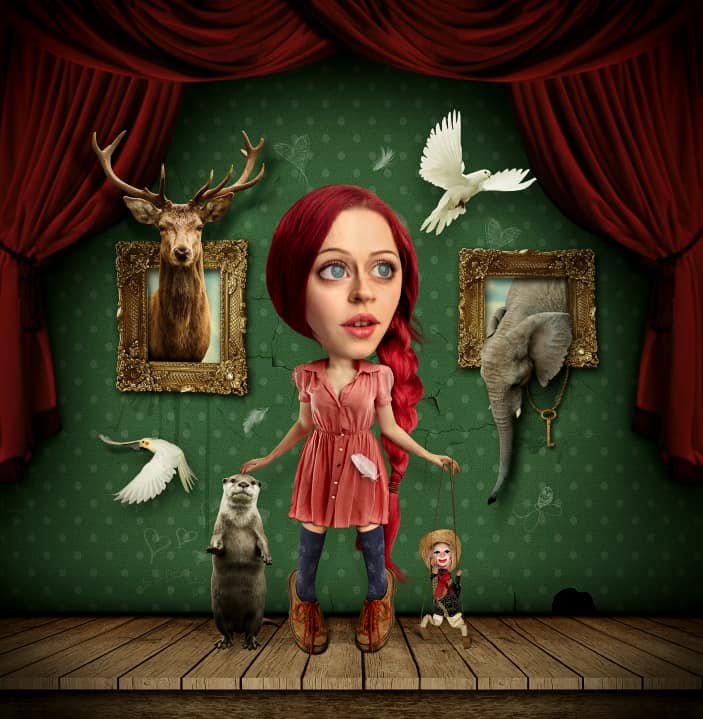Sometimes it’s good to have fun with Photoshop, and today, we are going to learn step by step how to create an amusing cartoon character using some photo manipulation techniques retouching, and many others. There are of course many ways to do it, but you may find a lot of useful tricks and techniques in this tutorial, and with a little bit of imagination, you can use it to create your own unique character. So, let’s get started!
Tutorial Resources
- Paper Texture
- Wood Texture
- Curtain
- Gold Frame
- Model 1, 2, 3
- Hair
- Deer
- Elephant
- Sky
- Bird 1, 2
- Marionette
- Otter
- Key
- Rope
- Feather Brush
- Ink Splatter Brush 1, 2
- Crack Brush
- Doodles Images
Step 1
Let’s start by creating a new canvas of 2800 x 2800 px and resolution of 72 px/inch. Always try to work on a large dimension because it gives us the advantage to adjust the image to a larger or smaller size without losing its quality. Now grab Paint Bucket Tool and fill the background with black.

Step 2
The first thing we need to do is to create a background. Go to File > Place and select a Paper Texture image. This will automatically turn the layer into a Smart Object. Because the Paper image is smaller than our canvas, we need to duplicate the layer a few times to cover up our canvas horizontally. Then add a Layer Mask to the duplicated layer, and by using a Gradient Tool, draw a Gradient on its edges to make the texture seamless horizontally. Hold down the Shift key to constrain the gradient to a perfect horizontal.
To cover the canvas vertically, just duplicate the layers and flip it vertically. The result will look like this.

Step 3
We need to create another texture on top of our Paper layers to make it stand a bit more. First, add a new layer on top of everything and fill it with black. Then go to > Filter > Noise > Add Noise, and set the Amount around 300%. You don’t have to be precise with the number here, as long as it looks good for you, go for it. Let your own eye be the judge.
Now go to Filter > Stylize > Emboss. Leave the default settings as it is and click OK. To brighten up this texture a little bit, add a Levels Adjustment Layer from the Layers Panel and move the Highlights slider to 165, but first we have to make sure a clipping mask is applied to the layer. Then set the Noise layer’s Blending Mode to Multiply and the Opacity to 28%.
13 responses to “Transform a Portrait Into a Caricature Artwork”
-
A disgraceful explanation. nothing is understood.
-
Hello, your tutorial sucks. It gives no context to what I am actually doing, and it just expects me to know things not explained. I don’t care about what you are going to say to this because my opinion is already formed that this tutorial is no good.
-
This is super cool. Inspired me to a new piece I’ve been wanting to do for a while. Thanks for sharing :)
-
Really your method is very easy and helpful. I get complete idea to the work. Thanks for your kind post.
-
It’s really great tutorial.but how to do the first step? I mean the Gradient step.
-
1. Create a new layer (Layer > New > Layer).
2. Select the Elliptical Marquee Tool (Press Shift+M until the icon in the toolbar turns into a circular marquee).
3. Go to Select > Modify > Feature. Set the Radius to 150px.
4. Go to Select > Modify > Inverse.
5. Press Shift+Backspace. Set the contents to black.
6. Lower the current layer’s opacity to 21%.
7. Duplicate the layer by pressing Ctrl+J (Cmd+J on Macs).
8. Go to Edit > Transform > Scale. Scale it up by around 137% or larger.
9. Lower the current layer’s opacity to 41%. -
exactly i have no clue
-
-
there is no tutorial on the dall looking girl?
-
how do i find out more about this please…very interested..thankyou
-
where is the add button??
-
GOOD!!
-
How to download this ??
-
wow am so inspire men good tin


Leave a Reply